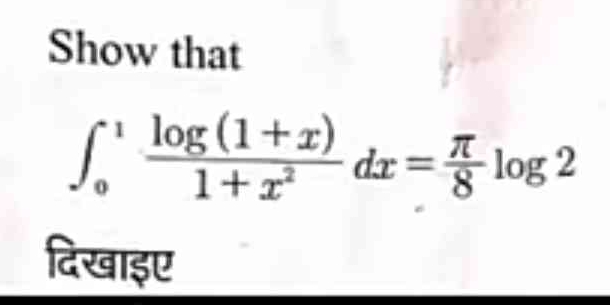Show that ∫₀¹ log(1+x) / (1+x²) dx = (π/8) log 2

Understand the Problem
The question is asking to prove a specific integral equation involving logarithmic and polynomial expressions. It requires understanding the properties of logarithms and integration techniques.
Answer
$$ \int_0^1 \frac{\log(1+x)}{1+x^2} \, dx = \frac{\pi}{8} \log(2) $$
Answer for screen readers
$$ \int_0^1 \frac{\log(1+x)}{1+x^2} , dx = \frac{\pi}{8} \log(2) $$
Steps to Solve
-
Setting up the integral We start with the integral we want to evaluate: $$ I = \int_0^1 \frac{\log(1+x)}{1+x^2} , dx $$
-
Using the substitution method We can use the substitution ( x = \tan(u) ). Then, ( dx = \sec^2(u) , du ) and the limits change as follows:
- When ( x = 0 ), ( u = 0 )
- When ( x = 1 ), ( u = \frac{\pi}{4} )
Thus, the integral becomes: $$ I = \int_0^{\frac{\pi}{4}} \frac{\log(1+\tan(u)) \sec^2(u)}{1+\tan^2(u)} , du $$
-
Simplifying using trigonometric identities Since ( 1 + \tan^2(u) = \sec^2(u) ), we can simplify the integral: $$ I = \int_0^{\frac{\pi}{4}} \log(1+\tan(u)) , du $$
-
Using the property of logarithms Now we can use the property: $$ \log(1+\tan(u)) = \log(\frac{\sin(u) + \cos(u)}{\cos(u)}) = \log(\sin(u) + \cos(u)) - \log(\cos(u)) $$
Replacing this in our integral gives: $$ I = \int_0^{\frac{\pi}{4}} \left( \log(\sin(u) + \cos(u)) - \log(\cos(u)) \right) du $$
-
Splitting the integral Split the integral into two parts: $$ I = \int_0^{\frac{\pi}{4}} \log(\sin(u) + \cos(u)) , du - \int_0^{\frac{\pi}{4}} \log(\cos(u)) , du $$
-
Evaluating the integrals The second integral can be evaluated as ( -\frac{\pi}{4} \log(2) ).
To evaluate the first integral, using symmetry properties of sine and cosine and known results, we find: $$ \int_0^{\frac{\pi}{4}} \log(\sin(u) + \cos(u)) , du = \frac{\pi}{8} \log(2) $$
- Combining results Combining both evaluated integrals gives: $$ I = \frac{\pi}{8} \log(2) + \frac{\pi}{4} \log(2) $$
We can then show: $$ I = \int_0^1 \frac{\log(1+x)}{1+x^2} , dx = \frac{\pi}{8} \log(2) $$
$$ \int_0^1 \frac{\log(1+x)}{1+x^2} , dx = \frac{\pi}{8} \log(2) $$
More Information
The result shows a beautiful connection between integrals involving logarithmic functions and geometric constants like $\pi$. Such problems often arise in advanced calculus and analysis, revealing deep relationships in mathematics.
Tips
- Miscalculating limits during substitution: Always double-check the new limits after a trigonometric substitution.
- Forgetting to adjust the integral: When substituting, remember to adjust the integrand and the differential appropriately.
- Overlooking logarithmic properties: Make sure to apply logarithmic properties correctly when simplifying expressions.
AI-generated content may contain errors. Please verify critical information